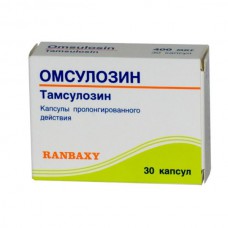Expiration date: 01/2026
Structure and Composition:
The long-acting capsules. One capsule contains tamsulosin hydrochloride 400 mcg
in blister 10 pcs. a stack of cardboard 1, 3 or 10 blisters
Description pharmaceutical form:
Hard gelatin capsules ?2 with orange body and a brown cap, printed with black ink «R» on the lid and «TSN 400" on the package, the contents of the capsules - white or almost white granules.
Pharmacokinetics:
After oral tamsulosin is rapidly and almost completely absorbed in the digestive tract. The bioavailability of the drug - about 100%. After a single oral administration of 0.4 mg of drug in plasma Cmax achieved after 6 h. The equilibrium concentration state (after 5 days of course taking) the maximum concentration of tamsulosin in blood plasma by 60-70% higher than after a single dose. Binding to plasma proteins - 99%. The volume of distribution - 0.2 l / kg. The product is not subject to the effect of "first pass" and is slowly metabolized in the liver with the formation of pharmacologically active metabolites with high selectivity for alpha 1-adrenoceptor. Most tamsulosin is present in the blood in an unmodified form. The drug and its metabolites are excreted by the kidneys, about 9% - unchanged. T1 / 2 with single dose - 10-12 hours.
Description of the pharmacological actions:
Omsulosin selectively and competitively blocks postsynaptic alpha1-adrenergic receptors located in the smooth muscle of the prostate, bladder neck and prostatic urethra and alfa1D adrenoreceptors located predominantly in the body of the bladder.
This leads to a reduction in smooth muscle tone of the prostate, bladder neck and prostatic urethra improve detrusor function, whereby the symptoms of obstruction and reduced irritation associated with benign prostatic hyperplasia. The therapeutic effect usually develops within 2 weeks after starting the drug, although in some patients the decrease of symptoms observed after the first dose.
The ability to influence the tamsulosin alpha1-adrenoceptors 20 times greater than its ability to interact with alfa1B-adrenoceptors are located in vascular smooth muscle. Due to such a high selectivity of the drug does not cause a clinically significant reduction in systemic blood pressure both in hypertensive patients and in patients with normal baseline BP.
Indications:
Treatment of the functional symptoms of benign prostatic hyperplasia.
Contraindications:
Hypersensitivity to the drug.
Carefully:
- chronic renal failure (Cl creatinine decrease <10 ml / min)
- hypotension (including orthostatic)
- severe hepatic impairment.
Side effect:
Rarely - dizziness, headache, fatigue, sleep disturbances (drowsiness or insomnia), retrograde ejaculation, decreased libido, pain, back pain, rhinitis, nausea, vomiting, constipation, diarrhea and in rare cases - orthostatic hypotension, tachycardia, palpitations, chest pain cell in very rare cases - hypersensitivity reactions (rash, pruritus, angioedema).
Drug Interactions:
In an application with cimetidine Omsulosin was a slight increase in tamsulosin concentration in blood plasma, and furosemide - decreased concentration, but it does not require a change in dose Omsulosin.
Diclofenac and warfarin may slightly increase the rate of elimination of tamsulosin. Simultaneous with the appointment Omsulosin with other alpha1-blockers may lead to a marked strengthening of the hypotensive effect.
Dosage and administration:
Inside, after the first meal, drinking plenty of water, 1 caps. (400 mg) per day. The capsule is not recommended to chew, because this may have an effect on the release rate of tamsulosin.
Overdose:
No cases of acute overdose have been reported.
Symptoms: may cause severe hypotension.
Treatment: kardiotropnyh therapy. If the symptoms persist, you should enter obemozameschayuschie solutions or vasoconstrictor drugs. To prevent further absorption of the drug possible gastric lavage, activated charcoal or osmotic laxative.
Special instructions:
Omsulosin should be used with caution in patients with a predisposition to orthostatic hypotension. At the first signs of orthostatic hypotension (dizziness, weakness), the patient should sit or lay.
Before the start of the drug is necessary to verify the diagnosis.
In patients with impaired renal function does not require dose reduction.
During the period of treatment must be careful when driving and occupation of other potentially hazardous activities that require high concentration and psychomotor speed reactions.


